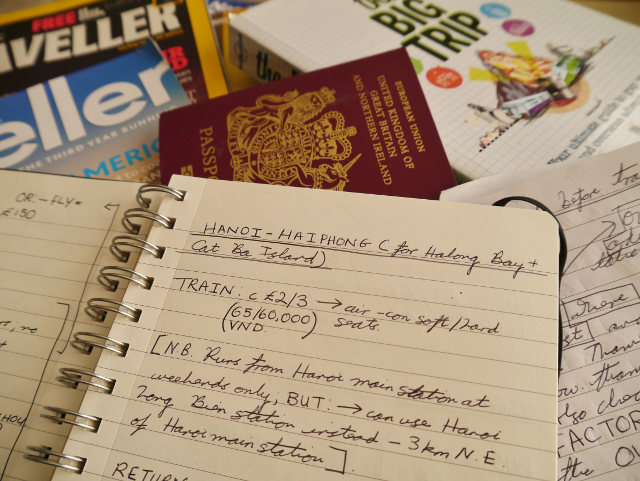It’s difficult to remember the exact point in time I decided to go away traveling. The idea probably didn’t have a single instance of germination, instead growing from a series of events and thoughts that occurred over months, even years – as a child I was engrossed in stories of jungle treks, arctic expeditions, and desert adventures, and my insistence that there must be more continents to discover flew in the face of scientific consensus.
And yet, however my decision came into being, it’s true the specifics of it remained for many months an intangible idea, its particulars lost to the ether. I remember having the incredibly naïve notion that organizing such a trip would be, if not simple, then at least rather easy. How wrong I was. In reality it takes a great deal of time, exhaustive research, and plenty of hard graft, to transform the myriad of confused – and often conflicting – ideas into something palpable and concrete.
Sign up today for Plan Your RTW Trip in 30 Days and start receiving email lesson plans tomorrow – it’s free!![]()
There are simply so many factors to consider, from the initial hazy “Where to go?” to the highly specific “Which visa do you need to trek in Thailand’s Khao Sok National Park?” As I, alongside my travel partner – my boyfriend – planned a trip to journey from the teahouses of Nepal to the islands of New Zealand (and many other places in between), I’ve gradually come to see there are several stages in creating and organizing such an adventure, each having their own frustrations and elations.
Five stages in fact, starting with…
Stage one – Vague ideas

Deciding to travel is the simple part. Choosing just where to go and what to do is somewhat more arduous. Our heads were filled with never ending possibilities, numerous destinations popping up in our imaginations, and questions, too:
- What sort of trip it would be?
- Would we join a tour or go independently?
- Focus on city life or the outdoors?
- Work or volunteer?
Pinning all this down was easier said than done. We were greedy. We wanted to go everywhere, to do everything.
This stage is indispensable in helping you realize the specific character, the focal point, of your trip.
What’s funny about this stage is that, while eventually you’ll have to marshal the mayhem, it’s in fact useful to let a multiplicity of possibilities run free, unhindered. Without comparing and contrasting different prospects, you won’t explore all your options, and might actually restrict your choices on the basis of mere whims. Without being as open minded we might not have realized our hearts lay with adventure travel, independently exploring landscapes and natural areas. This stage is indispensable in helping you realize the specific character, the focal point, of your trip.
Read What is Your Why? if you are having trouble getting your planning started
Stage two – The birth of the route

Then again, there are limits to what this can achieve. Daydreaming alone can’t turn your trip into a tangible reality. For a plan to be set in motion you need parameters. Research is invaluable here – and in fact a continuing necessity from now on – allowing you to narrow down countless choices. Travel guides are often essential for details, as are articles and blogs, material that also helps to convey the atmosphere and feeling of particular places. From your research, you’ll have to dismiss more than a few ideas, whether on the basis of budget, a lack of suitable attractions, climate, or a host of other considerations. After much deliberation, South East Asia became our preferred choice – budget wise it was purse friendly, transport links appeared decent, and it was different enough to give us a much needed culture shock.
During this stage if you’re traveling with someone, compromising is crucial. An initial naïve perspective that you can both do everything you want will quickly be challenged. You’ll be forced to be completely frank with one another. Arguing, although inevitable, is really just a waste of time. After all, a stalemate won’t get you anywhere. And remember, there are positives to a travel companion – you’ll think about possibilities that alone you may not have considered, and your plans will become increasingly refined as you bounce ideas off each other. There’s also the added benefit of traveling with someone familiar in a very unfamiliar situation.
Don’t spread yourself too thin – in depth exploration of a few countries is better than skimming the surface of many.
From here, your plan will continue to develop. In continuing to research your geographical area of choice you’ll not only narrow down your route, you’ll also, by concentrating on considerations such as political and economic climates, cultural backgrounds, prices, transport links, weather patterns and seasons, and the availability of flights, discover important information on those countries you’ll eventually visit, as well as producing a basic timescale for travel. For us, several countries fell by the wayside, one of them India, which due to its size and complexity, we deemed a whole other trip in itself. Information from contacts can also help in determining certain specifics – a friend who’d trekked in Nepal suggested that, to avoid being overwhelmed by tourists, we should choose the Manaslu trek over the Annapurna circuit. Such local knowledge is invaluable.
While researching, keep an eye on your budget. Don’t spread yourself too thin – in depth exploration of a few countries is better than skimming the surface of many. In this way a restricted budget is useful – you hone in on precisely what you most want.
Without quick decisions it’s easy to become stuck in a quagmire, constantly debating what’s the better option.
Sometimes your decisions might feel rather arbitrary, but the alternative is paralysis by analysis. Without quick decisions it’s easy to become stuck in a quagmire, constantly debating what’s the better option. Impulsive decisions are useful, often necessary to move you forward. Despite this, the structure of you route might not come easily. For us it was constantly being altered, re-altered, finalized, then changed, and changed again.
It’s a slow process, but persevere – eventually it’ll form itself into a basic structure and your plans will begin to solidify. It’s a satisfying feeling – the trip as something tangible, a goal you can work towards, not the evasive, abstract notions of several months before.
Need help planning your route? Become a BootsnAll member!
Stage three – The particulars

This is the longest, most labor intensive part of the whole process. Here you’ll deal with researching and organizing visas, vaccinations, insurance, and all the other minutiae that comes with traveling through multiple countries.
Settling such matters can be a long, involved process. Whole essays could be written on each of these topics! You’ll have to deal with masses of – at times confusing and mundane – information. You may write endless enquires to embassies, doctors, and tourist boards, and include all these necessities within your budget. If you’re planning to work or volunteer, too, now is the time to look into it. We wanted to work in New Zealand at the end of our trip, and so we spent some time looking at the job opportunities and more permanent accommodation on offer. In such cases there are often multiple visas to choose from, and you might need extra vaccinations depending on the type of work or volunteering you’re going for.
Your itinerary shouldn’t be definite, unchanging, and with a rigorous timescale.
Then again, don’t micromanage. Your itinerary shouldn’t be definite, unchanging, and with a rigorous timescale. If it is, you’ll end up missing the very things you came to see. It’ll fall apart anyway when it comes into contact with everyday, traveling life.
Yet for those things where research is crucial, each issue will involve something different. With insurance and flights, try to balance cost and reliability. Usually this involves perusing countless comparison sights and search engines, being committed enough to continue this process week after week. Looking at transport options within countries can follow a similar thread. How easy transport is to find depends more or less on your destination(s). We chose South East Asia as it has a relatively decent transport infrastructure, with a diversity of options, allowing us to travel with greater ease – useful for travelers on their first big trip outside Europe. As a starting point check out each country’s tourist website – most will direct you to information on trains, buses, taxis, and ferries.
When it comes to vaccinations, everyone has their own opinions, and you need to do whatever’s right for you. For us, that meant gettomg whatever’s necessary, whatever the costs – it sounds melodramatic, but it might just save your life. It’s also good to look at a vaccination’s quality – several anti-malarials are known for their side-effects. Thankfully, you don’t need to deal these questions alone – a medical professional can help.
One area in particular is difficult to navigate – visas. Finding information on this topic via government websites can be difficult – sometimes information isn’t present or links don’t work. More often than not they’re filled with indeterminable bureaucratic slogans. If you manage to find the information, working out which visa suits you best can be tough. When in doubt e-mail the country’s embassy, who will usually give you the exact response you need. The forms themselves can be long-winded, time consuming, and frustrating. At points your patience will wear thin. Try putting photographs of your destinations next to you to keep you focused on the final goal.
Despite the difficulties associated with the above you’ll probably, and rather surprisingly, enjoy the whole process. This stems from knowing, with each e-mail sent, form filled in, or call made, you’re at long last getting somewhere. Foundations are being put down that will bring your journey, finally, to life.
Sign up for Plan Your RTW Trip in 30 Days – the free email planning program offered through BootsnAll
Stage four – Paying up

It may be the shortest and simplest stage of trip organization, but paying up is actually one of the most frightening. Before, little purchases like backpacks, torches, and buffs were easy to buy, but they don’t really finalize anything, so there’s no pressure. But buying insurance and visas, getting vaccinated, and – biggest of all – committing to flights, is simply terrifying. Not only the biggest costs, they seal the deal. There’s no going back. Don’t worry – once you get over the initial shock, it’s simply exhilarating. Soon you will be leaving.
Don’t worry – once you get over the initial shock, it’s simply exhilarating. Soon you will be leaving.
The only thing that might bring you down a little is organizing the many documents that come with purchasing flights, insurance, visas – they all must be checked, photocopied, and ordered. While relatively simple and very necessary, it’s a time-consuming task.
Stage five – The waiting game

The easiest stage by far. There’s the understandable anxiety that something will go wrong, but really this stage is about enjoying the mounting excitement! It’s a good idea to keep researching – something so crucial in the beginning does not lose its utility now. You can always learn more, and improve your trip even further!
Most time here is filled with picking up little extras (first aid kits, extra camera batteries, travel towels), and counting down the days… It’s fun to look at photographs of your destinations, getting more and more excited that soon, very soon, you’ll be there.
Read 13 Ways to Beat the RTW Travel Planning Doldrums
A note on setbacks

Just a little word of warning – don’t be put off by setbacks. During stage three I strained the bottom of my foot (the culprit’s name is plantar fasciitis), and I’m still waiting for it to fully heal. While incredibly frustrating, forcing me to alter dates and affecting my funds, the injury did have its positives. It’s made us determined to be as fit as possible for the trip, made us pay a lot more attention to insurance policies (if worse comes to worst it’s best to have some form of cancellation guarantee), and has just strengthened my resolve that, come February next year, we will be getting on a plane to Nepal.
Read How to Stay Motivated during trip planning
The stages themselves
Planning a Big Trip is a frustrating and exhilarating experience. From the beginning it’s never a straightforward process, and indeed the stages above do not flow seamlessly from one to the other. It’s messy (as with so many things in life), the stages often overlapping. Sometimes my research during stage three forced me to go back and reassess my choices in stage two, and revising things on the basis of my budget was an on-going process. Planning is never clear cut, and although often frustrating, it’s also half the fun. Organizing something like this is an achievement you’ll carry with you forever – it’s just a bonus you’ll get to enjoy the actual traveling too!
Currently living in the wilds of Highland Scotland, Rachel is planning a year long trip with her boyfriend to South East Asia and Australasia starting in 2014. To read more from and about Rachel, check out her traveler profile.
Photo credits: ToastyKen, Switchback Travel, epSos.de, Foxtongue, thedailyenglishshow, all other photos courtesy of the author and may not be used without permission.
